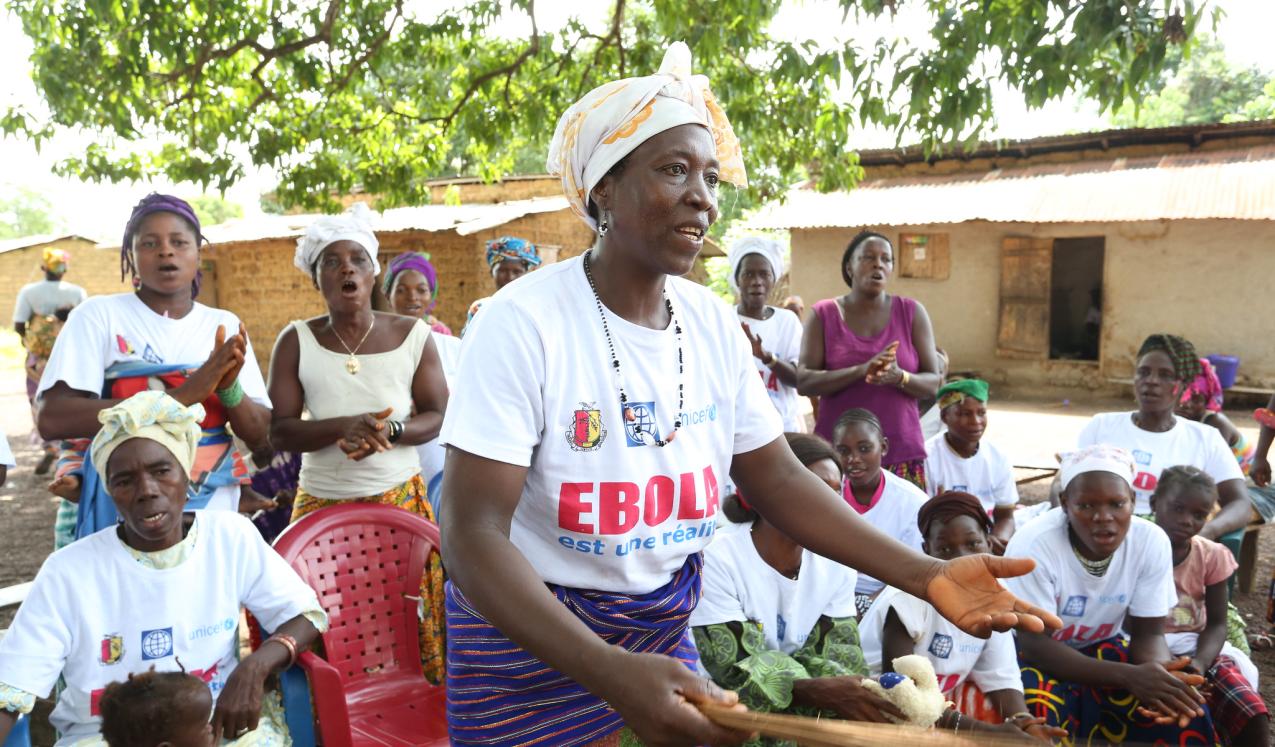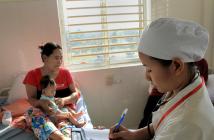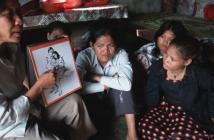
Gender norms and infectious and communicable diseases
Data indicate a shift in the global burden of disease. Worldwide, between 1990 and 2017, there was a 41% decrease in death and disability caused by communicable diseases and a 40% increase in non-communicable diseases. There have been impressive successes in limiting the impact of communicable diseases – diseases that spread from one person or vector to the next. Even so, communicable diseases still threaten the health and wellbeing of people living in low-income settings.
Communicable diseases include the triplex of malaria, HIV and tuberculosis (TB), which have been a focus for health governance bodies, prompting the establishment of the Global Fund, and the global commitment to Goal three of the UN Sustainable Development Goals, which aims to address their combined threat. In addition, the emerging dangers of infectious diseases such as the Zika virus and Ebola have captured the attention of the global health community.
Because the transmission of communicable diseases depends on interactions between those who are infected and those who are not, or contact with disease-bearing vectors, such as mosquitos or water, a significant behavioural context allows these diseases to continue to propagate. The behaviour patterns of individuals – including gender norms – often shape the likelihood of being infected.
A mass of evidence tells us that gender norms dictate how men and women live their lives and the activities they are allowed to undertake. In the context of communicable and infectious diseases, gender norms interact with the method of transmission and shape infection rates that differ for men and women.
As men are more likely to spend time outside, their likelihood of infection by mosquito is higher
Malaria and Zika virus, for example, are both diseases transmitted by mosquitos. As men are more likely to spend time outside, either working in forested areas, socialising at night or sleeping outside, their likelihood of infection by mosquito vector is higher than for women. Gender-sensitive interventions are, therefore, required to address these infectious diseases comprehensively. Some programmes have focused on gender gaps in health knowledge and access, formal education and livestock ownership and on identifying gender equity disparities as the opportune point of intervention in preventing the spread of mosquito-borne disease. In addition, interventions to tackle specific gender norms have been developed in response to malaria and Zika epidemics and are highlighted below.
Zika virus is also propagated through sexual contact and shares that feature with HIV and other sexually transmitted infections. When an infectious disease contains a link to sexual contact, the issue is often immediately framed as a reproductive and sexual health issue and, as such, falls into the realm of women's health and family planning. As a result, such diseases are often framed as the sole ‘responsibility’ of women and interventions will use prevention and education tactics around family planning, as well as during counselling sessions for women in antenatal care.
Elevating a woman's socioeconomic status and position in society decreases her likelihood of infection
There are, however, examples of gender transformative interventions that aim to tackle this type of communicable disease. Studies reveal, for example, the positive impact of elevating a woman's socioeconomic status and position in society to decrease her likelihood of infection, as well as measures to expand men's involvement beyond the scope of family planning to share responsibility and decision-making equitably with their female partners.
It is noteworthy that tuberculosis and the impact of gender norms on stigma and discrimination have been widely identified in the literature. There are interventions that acknowledge the role of gender norms in TB infection and respond specifically to the health issues they create, such as female-only TB support groups in India that facilitate discussion of women's experience with TB and gender-based stigma. However, the effectiveness of these interventions has not been studied in depth and further pressure should be applied by the global health community to elevate these programmes.
Three studies, in particular, demonstrate promising interventions and policy developments to address gender norms and their impact on communicable diseases and are outlined below:
- a qualitative study from Monroe et al. (2019) of male migrant labourers in Zanzibar and community-led efforts to eliminate malaria cases.
- a randomised control trial from Baird et al. (2012) in Malawi to study the impact of cash-transfer programmes in the mitigation of HIV and herpes simplex type 2.
- a policy advocacy case from Osamar and Grady (2016) pushing for the greater inclusion and active participation of men in confronting the Zika epidemic.
Human behaviour and residual malaria transmission in Zanzibar: findings from in-depth interviews and direct observation of community events (2019)
Malaria and the global burden of disease it causes have both decreased significantly since the turn of the 21st century. As various countries in Africa, Asia and Latin America have eliminated malaria cases, its complete eradication has become conceivable.
Zanzibar, an island off the coast of Tanzania, offers great potential for its elimination as community-based efforts are mobilised to keep malaria cases ultra-low. 'The last mile,' or the final step in the delivery of preventive measures, has identified one sub-group as a target population for full eradication: male seasonal workers who travel frequently between the island and the mainland. Monroe et al. (2019) focus on an interesting intervention on the island, where workers come from the mainland to work in farms, small business and hotels for different months during the year.
Interventions with local residents have been tremendously successful and have relied on the use of insecticide-treated nets (ITNs) to prevent transmission of the malaria parasite. As a result of gender norms, men enjoy staying longer outside at night to socialise with other community members. Yet local prevention efforts are not focussed on outdoor prevention, which leaves men more susceptible to malaria. Men are also more likely to sleep outside, while women and children report sleeping indoors.
In addition, adult men account for the majority of the seasonable labour force who arrive to earn money to provide for their families on the mainland. They rarely arrive on the island with insecticide-treated nets (ITNs) or any other means of preventing malaria infection. The low use of ITNs among migrant workers is thought to be a result of low access and a lack of connection to the local community.
Community-based health workers have been instrumental in targeting subgroups as part of the drive towards malaria elimination
Community-based health workers, called locally sheha and assistant sheha, have been instrumental in targeting subgroups as part of the drive towards malaria elimination. In the case of seasonal workers, these health workers act as gatekeepers to their communities and ensure that malaria is not transmitted from the mainland to the island.
Migrant labourers must register on arrival with the sheha and undergo malaria diagnostic testing in order to stay in their assigned region. In addition, sheha have led educational campaigns to teach people about prevention tactics they can outdoors, which include the purchasing and use of mosquito repellents.
As seasonal workers and men are less likely to engage with local health services, their interactions with and testing by sheha have the potential to shift the gender norm that men should not use health-seeking behaviours. Sheha recognise the reality of daily life for men and workers in their communities and instead of instructing them to change their behaviour, they introduce effective alternatives to prevention that are adapted to their cultural contexts.
Effect of a cash transfer programme for schooling on prevalence of HIV and herpes simplex type 2 in Malawi: a cluster randomised trial (2012)
Shifting culturally-based gender norms does not always rely on targeted, community-based messaging. Current social norms often dictate that women should rely on men for financial stability and, as a result, women are put in a position where they engage in risky sexual behaviours in exchange for gifts, money, and assistance. This creates an environment where sexually-transmitted communicable diseases, such as HIV, syphilis and herpes simplex virus 2 (HSV-2), are propagated and where unwanted pregnancies continue.
Gender norms represent a widespread reality of insufficient and unequal distribution of resources
Cash transfers to young women have been proposed and studied as a possible intervention to change gender norms, providing women with autonomy and improving their health. Given that these gender norms represent a widespread reality of insufficient and unequal distribution of resources and opportunities for boys and girls, cash transfers offer a chance to counter that reality.
Baird et al. (2012) chose to study the impact of cash transfers in the Zomba district of southern Malawi, using a randomised control trial, with half of the study areas receiving the cash transfer and the other half being the control group. The intervention areas received either unconditional or conditional cash transfers, with the condition being school attendance. The participants were never-married women aged 13 to 22, who were also selected randomly and given randomly assigned monthly payments. Data were obtained through interviews and biomarker tests.
The study found an overall decrease in the frequency of sexual activity and the age of sexual partners, which resulted in a decrease in HIV and HSV-2 prevalence in the cash transfer intervention group. In particular, HIV prevalence and the likelihood of having had a sexual partner aged 25 or older were both reduced significantly in the conditional cash group in comparison to the control group. In addition, the likelihood of being pregnant, having sexual intercourse once per week, and HSV-2 prevalence at the 18-month mark after the programme ended, had also decreased significantly when the unconditional cash transfer group was compared to the control group.
These findings demonstrate that a cash-transfer programme targeted towards women – even one that includes no measures or training related to communicable disease transmission – can have a major impact on health outcomes. Furthermore, the lack of health-related factors in the intervention shows that shifting gender norms by economically empowering women and girls who traditionally experience lower socioeconomic status, has an ameliorative effect on the condition of women burdened by communicable diseases, such as HIV and HSV-2.
Zika Virus: Promoting Male Involvement in the Health of Women and Families (2016)
When Zika virus seized the urgent attention of the global health community in 2015, a coordinated and comprehensive response had to be crafted. Zika's effect on an adult is relatively mild, causing fever, rash and muscle and joint pain. However, its effect on unborn children is far more harmful: babies are born with microcephaly, or clinically smaller heads, as well as intellectual and physical disabilities. Pregnant women and women trying to get pregnant are a key focus for healthcare professionals, but they do not bear the sole responsibility for the prevention of Zika virus transmission to their children.
Engaging men in health interventions has been repeatedly cited as critical to ensuring equitable health outcomes in communicable diseases, especially when transmission can occur through sexual activity, as in the Zika virus. Gender norms dictate that men act as the primary decision-makers around sexual activity, and whether they and their partners have safe sex or not.
A Zika outbreak is a community issue, not only a women's health issue
Osamor and Grady (2016) recommend promoting male participation in discourses surrounding Zika virus and involving them more actively in processes to address outbreaks. They emphasise the need for male involvement that goes well beyond family planning and contraceptive use to instil meaningful change. A Zika outbreak, they argue, is a community issue, not only a women's health issue.
Programmes should, therefore, include educational campaigns that target men specifically, rather than simply relying on their presence during antenatal care appointments, which men may or may not attend depending on geographic and cultural contexts. Counselling sessions that advocate for shared decision-making with their female partners and shared responsibility for contraceptive use and caring for Zika-affected children are crucial to address Zika outbreaks effectively.
This suggested approach is an interesting and novel gateway to help men begin to take more accountability for the health and wellbeing of themselves and their families. In the case of communicable diseases like Zika, community-based approaches and gender-transformative interventions are valuable solutions that have real potential to improve health outcomes and reduce the burden of disease.



